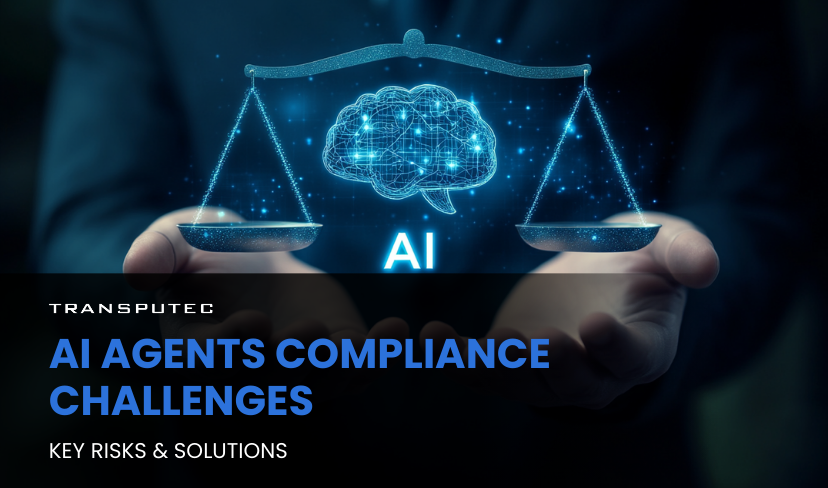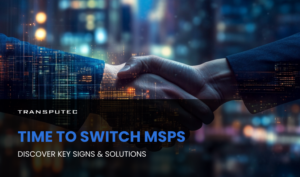Written by KRITIKA SINHA | MARKETING
AI is changing how companies work, and it’s happening fast. More and more businesses are using AI Agents to do tasks faster and smarter. These smart computer systems can learn and make decisions on their own. They can help companies work more efficiently and come up with new ideas.
Since AI can access tonnes of data, including private stuff, there’s always a risk something could go wrong. Companies need to be careful. They want the benefits of AI, but they also need to make sure their information stays protected. This blog dives deep into AI Agents Compliance Challenges, shedding light on the key risks, regulatory requirements, and strategies to maintain compliance. You’ll also discover how Transputec can help mitigate these risks, ensuring your AI implementations align with global compliance standards.
How do AI Agents work?
AI Agents are like smart digital helpers that can think and act on their own. They work by following a simple but powerful process: they look around, understand what’s happening, make a decision, and then take action. Think of an AI Agent as a curious robot that’s always learning. First, it collects information using “sensors.” These could be cameras, microphones, or ways to read text. Then it processes this information using clever computer algorithms that help it understand what’s going on.
What makes AI agents really cool is their ability to learn and improve over time. Each interaction helps them get smarter. They can handle tasks ranging from simple customer service chats to controlling complex robotic systems. They’re not just following strict rules, but adapting and making intelligent choices based on what they’ve experienced.
Understanding AI Agents Compliance Challenges
Businesses are being changed by AI agents, but there are compliance concerns related to them that need to be carefully managed. The following are some of the most significant compliance issues that businesses deal with:
1. Data Privacy and Protection
AI agents handle vast amounts of personal and sensitive data. Regulations like GDPR (General Data Protection Regulation), CCPA (California Consumer Privacy Act), and HIPAA (Health Insurance Portability and Accountability Act) impose strict rules on data collection, processing, and storage.
Key Challenges:
- Ensuring AI-driven data processing is transparent and ethical.
- Implementing robust consent management frameworks.
- Preventing unauthorised access or data leaks.
Solution:
Businesses must adopt privacy-first AI models, enforce data encryption, and regularly audit AI systems to maintain compliance.
2. Algorithmic Bias and Fairness
Bias in AI models can lead to discriminatory outcomes, causing regulatory and reputational risks. Studies show that biased AI can negatively impact hiring, lending, and law enforcement decisions.
Key Challenges:
- Identifying and mitigating bias in training datasets.
- Ensuring AI decisions are explainable and accountable.
- Complying with non-discrimination laws and ethical AI standards.
Solution:
Deploy bias-detection tools, diversify training datasets, and conduct periodic fairness assessments.
3. Transparency and Explainability
Regulatory bodies like the EU AI Act and FTC guidelines emphasise AI explainability to ensure fairness and accountability.
Key Challenges:
- AI decision-making often lacks transparency.
- Companies struggle to provide clear explanations of AI outcomes.
Solution:
Utilise explainable AI (XAI) frameworks to make AI decisions more interpretable for auditors, regulators, and end-users.
4. Cybersecurity Risks and Compliance
AI agents are prime targets for cyber threats, making cybersecurity compliance essential.
Key Challenges:
- AI systems can be exploited through adversarial attacks.
- Lack of clear cybersecurity regulations for AI.
Solution:
Implement multi-layered security, conduct regular penetration testing, and comply with ISO 27001 and NIST guidelines.
5. Legal and Ethical AI Governance
AI governance ensures compliance with industry regulations while maintaining ethical standards.
Key Challenges:
- Keeping up with evolving AI regulations.
- Establishing accountability for AI-driven decisions.
Solution:
Develop an AI governance framework, appoint compliance officers, and integrate audit trails.
How can Businesses Secure AI Agent Interactions?
Let’s talk about keeping your data safe when you’re using AI. It’s super important, especially since AI can handle tons of information. We need to set some ground rules to make sure AI doesn’t mess with sensitive stuff or go off doing things it shouldn’t. Here are three simple ways to stay on top of this:
1. Control who gets to use AI and keep data under wraps
First things first, decide who gets to play with your AI. It’s like having a bouncer at a club – only the right people get in. This way, you know exactly who’s accessing what. Also, use encryption. Think of it as a secret code that scrambles your data so only the right people can read it.
2. Put labels on your data
This is pretty straightforward. Label your data like you’d label food in your fridge. Some stuff is okay for everyone; some is just for you. By doing this with your data, you can tell your AI what it can and can’t touch. For example, you might label customer credit card info as “hands off” for most AI tasks.
3. Keep an eye on things
You’ve got to stay alert. Regularly check up on what your AI is doing, like you’d check your bank statement. This helps you spot any funny business quickly. Plus, keeping records of what’s happening is like having a safety net. It shows you’re on top of things if anyone asks questions.
How Transputec Helps Navigate AI Agents Compliance Challenges
Transputec offers tailored solutions to help businesses navigate AI Agent’s compliance challenges effectively. Here’s how we assist:
1. AI Compliance Audits: We conduct in-depth audits to identify and rectify compliance gaps in your AI systems.
2. Privacy-First AI Implementation: Our experts ensure AI models comply with GDPR, CCPA, and other data regulations.
3. Bias and Fairness Assessments: We use cutting-edge tools to detect and eliminate biases in AI decision-making.
4. Security-First AI Integration: Our cybersecurity solutions protect AI systems against cyber threats and ensure regulatory compliance.
5. Regulatory Guidance & Training: We provide businesses with the knowledge and tools to stay ahead of AI compliance regulations.
Conclusion
AI agents offer unparalleled efficiency and automation, but compliance risks can’t be overlooked. Businesses must address data privacy, algorithmic bias, transparency, cybersecurity, and AI governance to operate within legal boundaries.
With Transputec’s AI compliance solutions, you can confidently deploy AI while adhering to regulatory standards. Contact us today to connect with an expert and get started with Transputec.

Take the Next Step in Deploying AI Agents in Your Business?
Connect with an expert and get started on the next generation of IT support.
FAQs
What are the biggest AI compliance risks businesses face?
The primary risks include data privacy violations, biased decision-making, lack of transparency, cybersecurity threats, and regulatory non-compliance. Businesses must implement robust AI governance to mitigate these challenges.
How can Transputec help ensure AI compliance?
Transputec provides AI audits, regulatory guidance, cybersecurity solutions, and fairness assessments to ensure businesses meet global AI compliance standards.
Are AI compliance regulations the same worldwide?
No, regulations vary by region. GDPR (EU), CCPA (California), and PDPA (Singapore) are examples of different legal frameworks. Transputec helps businesses navigate region-specific compliance requirements.
Why is algorithmic bias a compliance issue?
Bias in AI can result in discriminatory decisions, leading to legal penalties and reputational damage. Regulators demand fairness and accountability, making bias mitigation a priority.
How does Transputec improve AI security compliance?
Transputec ensures AI security through encryption, penetration testing, AI governance frameworks, and adherence to ISO 27001 & NIST standards.







